Organisational Behaviour and Motivation Analysis: Spatial, plc
VerifiedAdded on 2020/12/30
|18
|4918
|294
Report
AI Summary
This report provides an in-depth analysis of the organisational behaviour of Spatial, plc, a multinational software company. It explores the influence of power, politics, and culture on team behaviour, individual performance, and the overall company. The report utilizes the Tuckman theory of team development and identifies key concepts of organisational behaviour through the Path-Goal theory, along with philosophies like collegial and supportive approaches. The analysis examines how culture, including role culture, impacts employees and the company's performance. The report also assesses the impact of different types of power, such as reward and legitimate power, and the influence of organizational politics on individual and team behaviour. Furthermore, it delves into motivation theories, including Maslow's hierarchy of needs and Herzberg's two-factor theory, to understand how to enhance employee engagement and productivity within Spatial, plc.
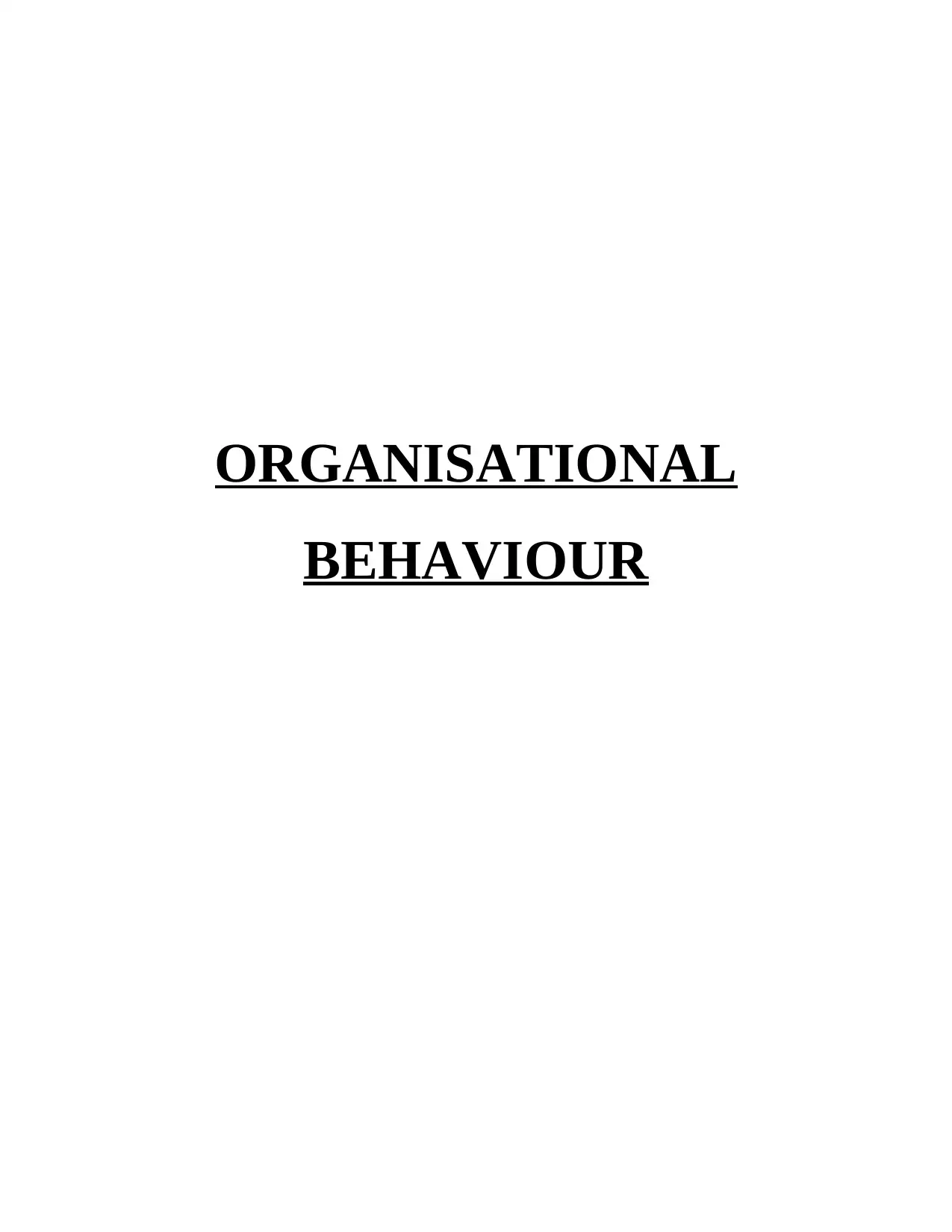
ORGANISATIONAL
BEHAVIOUR
BEHAVIOUR
Paraphrase This Document
Need a fresh take? Get an instant paraphrase of this document with our AI Paraphraser
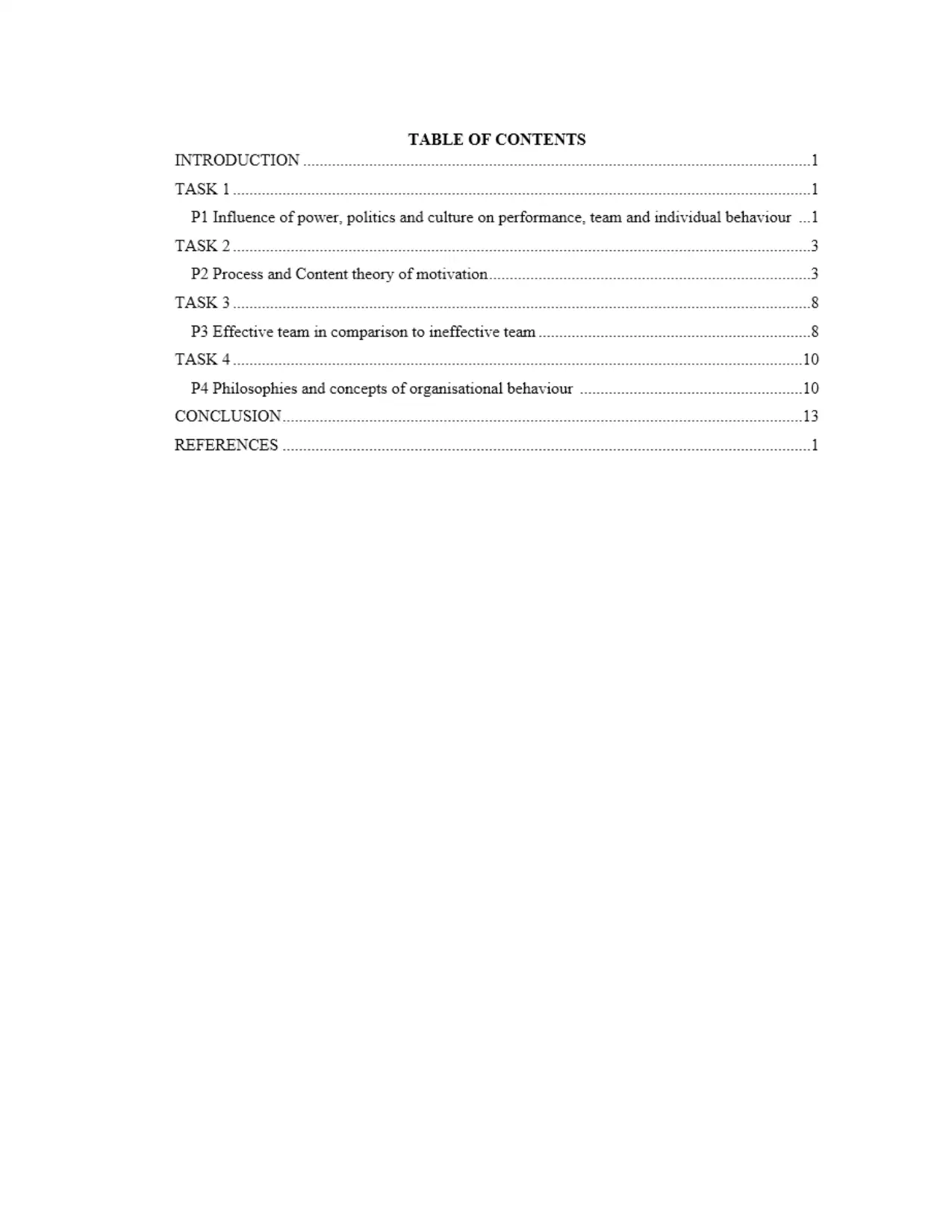
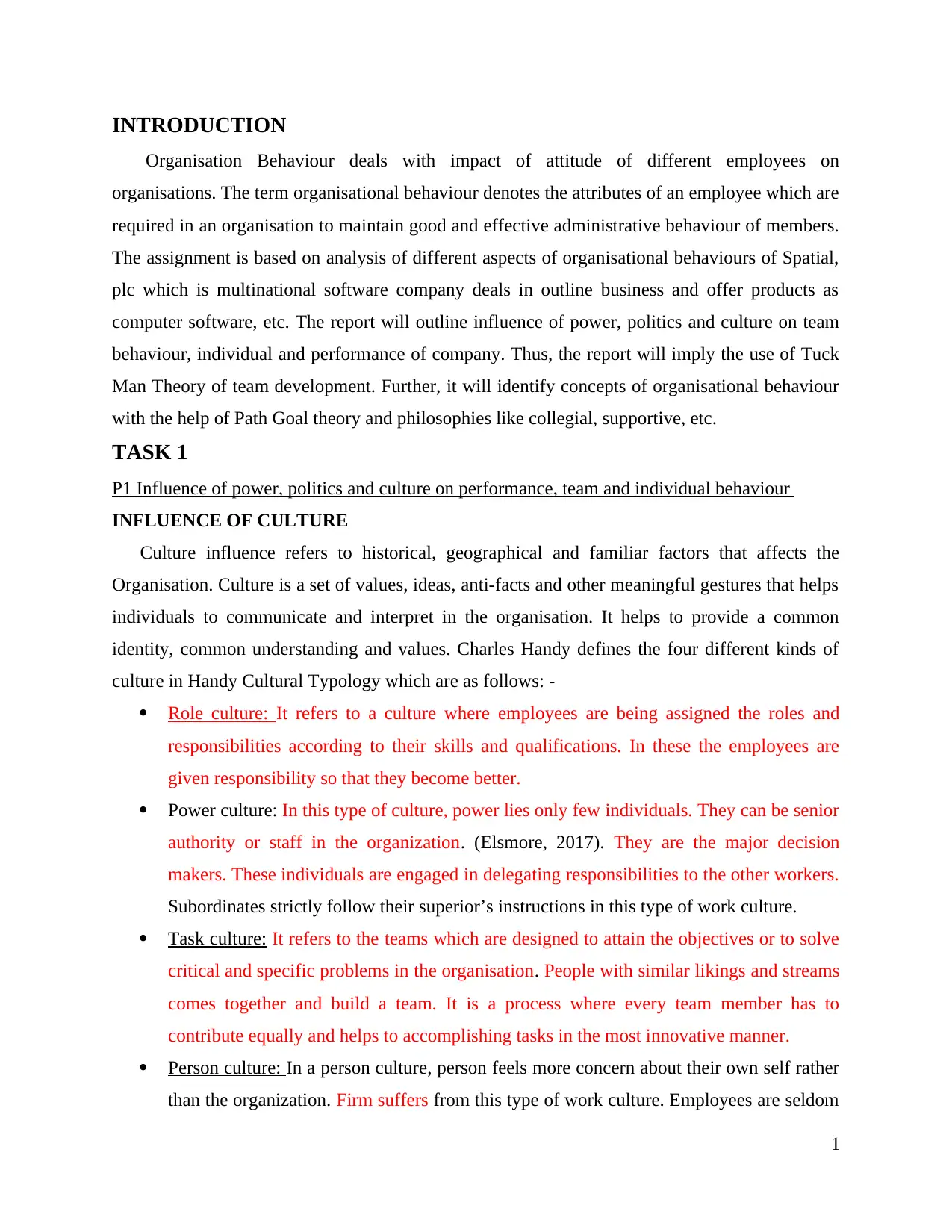
INTRODUCTION
Organisation Behaviour deals with impact of attitude of different employees on
organisations. The term organisational behaviour denotes the attributes of an employee which are
required in an organisation to maintain good and effective administrative behaviour of members.
The assignment is based on analysis of different aspects of organisational behaviours of Spatial,
plc which is multinational software company deals in outline business and offer products as
computer software, etc. The report will outline influence of power, politics and culture on team
behaviour, individual and performance of company. Thus, the report will imply the use of Tuck
Man Theory of team development. Further, it will identify concepts of organisational behaviour
with the help of Path Goal theory and philosophies like collegial, supportive, etc.
TASK 1
P1 Influence of power, politics and culture on performance, team and individual behaviour
INFLUENCE OF CULTURE
Culture influence refers to historical, geographical and familiar factors that affects the
Organisation. Culture is a set of values, ideas, anti-facts and other meaningful gestures that helps
individuals to communicate and interpret in the organisation. It helps to provide a common
identity, common understanding and values. Charles Handy defines the four different kinds of
culture in Handy Cultural Typology which are as follows: -
Role culture: It refers to a culture where employees are being assigned the roles and
responsibilities according to their skills and qualifications. In these the employees are
given responsibility so that they become better.
Power culture: In this type of culture, power lies only few individuals. They can be senior
authority or staff in the organization. (Elsmore, 2017). They are the major decision
makers. These individuals are engaged in delegating responsibilities to the other workers.
Subordinates strictly follow their superior’s instructions in this type of work culture.
Task culture: It refers to the teams which are designed to attain the objectives or to solve
critical and specific problems in the organisation. People with similar likings and streams
comes together and build a team. It is a process where every team member has to
contribute equally and helps to accomplishing tasks in the most innovative manner.
Person culture: In a person culture, person feels more concern about their own self rather
than the organization. Firm suffers from this type of work culture. Employees are seldom
1
Organisation Behaviour deals with impact of attitude of different employees on
organisations. The term organisational behaviour denotes the attributes of an employee which are
required in an organisation to maintain good and effective administrative behaviour of members.
The assignment is based on analysis of different aspects of organisational behaviours of Spatial,
plc which is multinational software company deals in outline business and offer products as
computer software, etc. The report will outline influence of power, politics and culture on team
behaviour, individual and performance of company. Thus, the report will imply the use of Tuck
Man Theory of team development. Further, it will identify concepts of organisational behaviour
with the help of Path Goal theory and philosophies like collegial, supportive, etc.
TASK 1
P1 Influence of power, politics and culture on performance, team and individual behaviour
INFLUENCE OF CULTURE
Culture influence refers to historical, geographical and familiar factors that affects the
Organisation. Culture is a set of values, ideas, anti-facts and other meaningful gestures that helps
individuals to communicate and interpret in the organisation. It helps to provide a common
identity, common understanding and values. Charles Handy defines the four different kinds of
culture in Handy Cultural Typology which are as follows: -
Role culture: It refers to a culture where employees are being assigned the roles and
responsibilities according to their skills and qualifications. In these the employees are
given responsibility so that they become better.
Power culture: In this type of culture, power lies only few individuals. They can be senior
authority or staff in the organization. (Elsmore, 2017). They are the major decision
makers. These individuals are engaged in delegating responsibilities to the other workers.
Subordinates strictly follow their superior’s instructions in this type of work culture.
Task culture: It refers to the teams which are designed to attain the objectives or to solve
critical and specific problems in the organisation. People with similar likings and streams
comes together and build a team. It is a process where every team member has to
contribute equally and helps to accomplishing tasks in the most innovative manner.
Person culture: In a person culture, person feels more concern about their own self rather
than the organization. Firm suffers from this type of work culture. Employees are seldom
1
⊘ This is a preview!⊘
Do you want full access?
Subscribe today to unlock all pages.

Trusted by 1+ million students worldwide
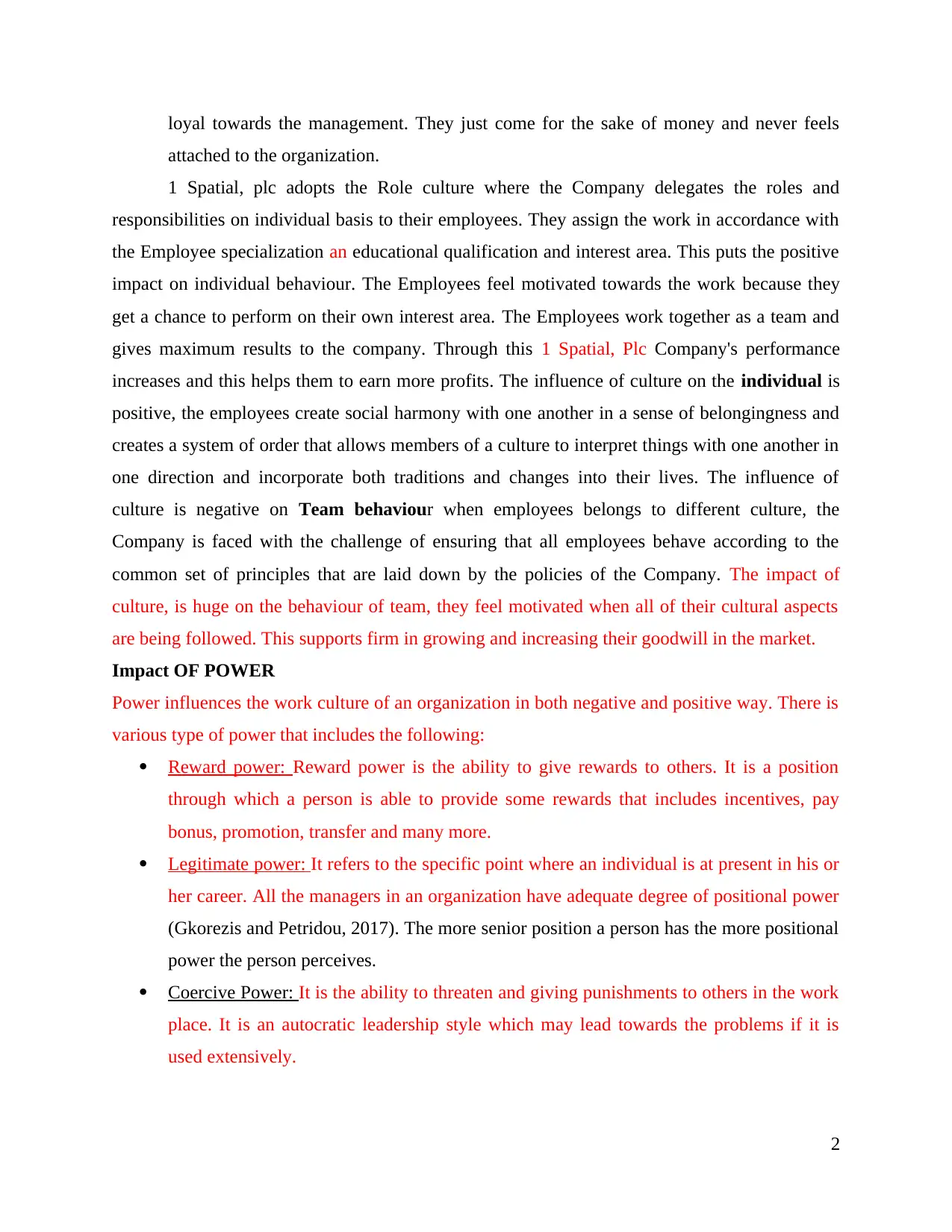
loyal towards the management. They just come for the sake of money and never feels
attached to the organization.
1 Spatial, plc adopts the Role culture where the Company delegates the roles and
responsibilities on individual basis to their employees. They assign the work in accordance with
the Employee specialization an educational qualification and interest area. This puts the positive
impact on individual behaviour. The Employees feel motivated towards the work because they
get a chance to perform on their own interest area. The Employees work together as a team and
gives maximum results to the company. Through this 1 Spatial, Plc Company's performance
increases and this helps them to earn more profits. The influence of culture on the individual is
positive, the employees create social harmony with one another in a sense of belongingness and
creates a system of order that allows members of a culture to interpret things with one another in
one direction and incorporate both traditions and changes into their lives. The influence of
culture is negative on Team behaviour when employees belongs to different culture, the
Company is faced with the challenge of ensuring that all employees behave according to the
common set of principles that are laid down by the policies of the Company. The impact of
culture, is huge on the behaviour of team, they feel motivated when all of their cultural aspects
are being followed. This supports firm in growing and increasing their goodwill in the market.
Impact OF POWER
Power influences the work culture of an organization in both negative and positive way. There is
various type of power that includes the following:
Reward power: Reward power is the ability to give rewards to others. It is a position
through which a person is able to provide some rewards that includes incentives, pay
bonus, promotion, transfer and many more.
Legitimate power: It refers to the specific point where an individual is at present in his or
her career. All the managers in an organization have adequate degree of positional power
(Gkorezis and Petridou, 2017). The more senior position a person has the more positional
power the person perceives.
Coercive Power: It is the ability to threaten and giving punishments to others in the work
place. It is an autocratic leadership style which may lead towards the problems if it is
used extensively.
2
attached to the organization.
1 Spatial, plc adopts the Role culture where the Company delegates the roles and
responsibilities on individual basis to their employees. They assign the work in accordance with
the Employee specialization an educational qualification and interest area. This puts the positive
impact on individual behaviour. The Employees feel motivated towards the work because they
get a chance to perform on their own interest area. The Employees work together as a team and
gives maximum results to the company. Through this 1 Spatial, Plc Company's performance
increases and this helps them to earn more profits. The influence of culture on the individual is
positive, the employees create social harmony with one another in a sense of belongingness and
creates a system of order that allows members of a culture to interpret things with one another in
one direction and incorporate both traditions and changes into their lives. The influence of
culture is negative on Team behaviour when employees belongs to different culture, the
Company is faced with the challenge of ensuring that all employees behave according to the
common set of principles that are laid down by the policies of the Company. The impact of
culture, is huge on the behaviour of team, they feel motivated when all of their cultural aspects
are being followed. This supports firm in growing and increasing their goodwill in the market.
Impact OF POWER
Power influences the work culture of an organization in both negative and positive way. There is
various type of power that includes the following:
Reward power: Reward power is the ability to give rewards to others. It is a position
through which a person is able to provide some rewards that includes incentives, pay
bonus, promotion, transfer and many more.
Legitimate power: It refers to the specific point where an individual is at present in his or
her career. All the managers in an organization have adequate degree of positional power
(Gkorezis and Petridou, 2017). The more senior position a person has the more positional
power the person perceives.
Coercive Power: It is the ability to threaten and giving punishments to others in the work
place. It is an autocratic leadership style which may lead towards the problems if it is
used extensively.
2
Paraphrase This Document
Need a fresh take? Get an instant paraphrase of this document with our AI Paraphraser
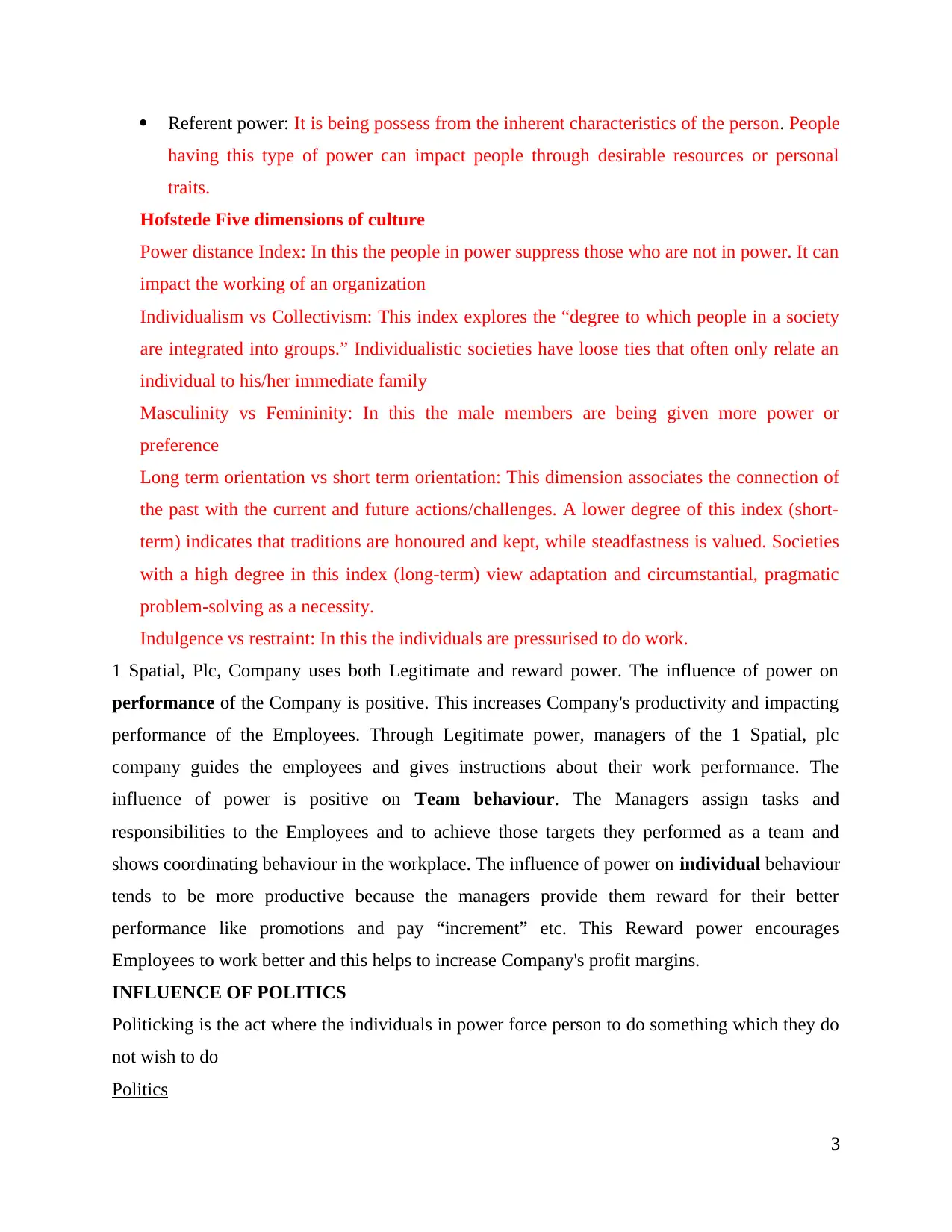
Referent power: It is being possess from the inherent characteristics of the person. People
having this type of power can impact people through desirable resources or personal
traits.
Hofstede Five dimensions of culture
Power distance Index: In this the people in power suppress those who are not in power. It can
impact the working of an organization
Individualism vs Collectivism: This index explores the “degree to which people in a society
are integrated into groups.” Individualistic societies have loose ties that often only relate an
individual to his/her immediate family
Masculinity vs Femininity: In this the male members are being given more power or
preference
Long term orientation vs short term orientation: This dimension associates the connection of
the past with the current and future actions/challenges. A lower degree of this index (short-
term) indicates that traditions are honoured and kept, while steadfastness is valued. Societies
with a high degree in this index (long-term) view adaptation and circumstantial, pragmatic
problem-solving as a necessity.
Indulgence vs restraint: In this the individuals are pressurised to do work.
1 Spatial, Plc, Company uses both Legitimate and reward power. The influence of power on
performance of the Company is positive. This increases Company's productivity and impacting
performance of the Employees. Through Legitimate power, managers of the 1 Spatial, plc
company guides the employees and gives instructions about their work performance. The
influence of power is positive on Team behaviour. The Managers assign tasks and
responsibilities to the Employees and to achieve those targets they performed as a team and
shows coordinating behaviour in the workplace. The influence of power on individual behaviour
tends to be more productive because the managers provide them reward for their better
performance like promotions and pay “increment” etc. This Reward power encourages
Employees to work better and this helps to increase Company's profit margins.
INFLUENCE OF POLITICS
Politicking is the act where the individuals in power force person to do something which they do
not wish to do
Politics
3
having this type of power can impact people through desirable resources or personal
traits.
Hofstede Five dimensions of culture
Power distance Index: In this the people in power suppress those who are not in power. It can
impact the working of an organization
Individualism vs Collectivism: This index explores the “degree to which people in a society
are integrated into groups.” Individualistic societies have loose ties that often only relate an
individual to his/her immediate family
Masculinity vs Femininity: In this the male members are being given more power or
preference
Long term orientation vs short term orientation: This dimension associates the connection of
the past with the current and future actions/challenges. A lower degree of this index (short-
term) indicates that traditions are honoured and kept, while steadfastness is valued. Societies
with a high degree in this index (long-term) view adaptation and circumstantial, pragmatic
problem-solving as a necessity.
Indulgence vs restraint: In this the individuals are pressurised to do work.
1 Spatial, Plc, Company uses both Legitimate and reward power. The influence of power on
performance of the Company is positive. This increases Company's productivity and impacting
performance of the Employees. Through Legitimate power, managers of the 1 Spatial, plc
company guides the employees and gives instructions about their work performance. The
influence of power is positive on Team behaviour. The Managers assign tasks and
responsibilities to the Employees and to achieve those targets they performed as a team and
shows coordinating behaviour in the workplace. The influence of power on individual behaviour
tends to be more productive because the managers provide them reward for their better
performance like promotions and pay “increment” etc. This Reward power encourages
Employees to work better and this helps to increase Company's profit margins.
INFLUENCE OF POLITICS
Politicking is the act where the individuals in power force person to do something which they do
not wish to do
Politics
3
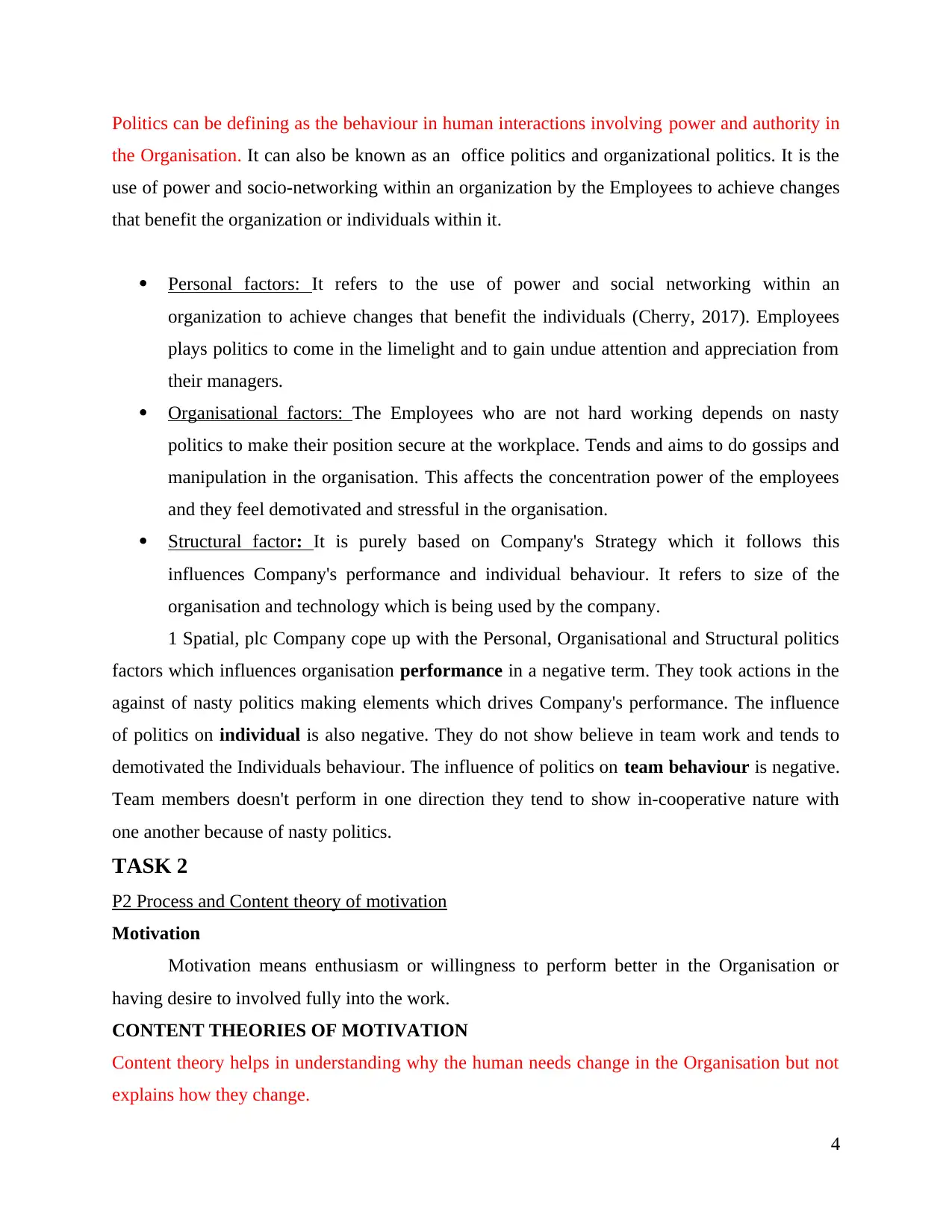
Politics can be defining as the behaviour in human interactions involving power and authority in
the Organisation. It can also be known as an office politics and organizational politics. It is the
use of power and socio-networking within an organization by the Employees to achieve changes
that benefit the organization or individuals within it.
Personal factors: It refers to the use of power and social networking within an
organization to achieve changes that benefit the individuals (Cherry, 2017). Employees
plays politics to come in the limelight and to gain undue attention and appreciation from
their managers.
Organisational factors: The Employees who are not hard working depends on nasty
politics to make their position secure at the workplace. Tends and aims to do gossips and
manipulation in the organisation. This affects the concentration power of the employees
and they feel demotivated and stressful in the organisation.
Structural factor: It is purely based on Company's Strategy which it follows this
influences Company's performance and individual behaviour. It refers to size of the
organisation and technology which is being used by the company.
1 Spatial, plc Company cope up with the Personal, Organisational and Structural politics
factors which influences organisation performance in a negative term. They took actions in the
against of nasty politics making elements which drives Company's performance. The influence
of politics on individual is also negative. They do not show believe in team work and tends to
demotivated the Individuals behaviour. The influence of politics on team behaviour is negative.
Team members doesn't perform in one direction they tend to show in-cooperative nature with
one another because of nasty politics.
TASK 2
P2 Process and Content theory of motivation
Motivation
Motivation means enthusiasm or willingness to perform better in the Organisation or
having desire to involved fully into the work.
CONTENT THEORIES OF MOTIVATION
Content theory helps in understanding why the human needs change in the Organisation but not
explains how they change.
4
the Organisation. It can also be known as an office politics and organizational politics. It is the
use of power and socio-networking within an organization by the Employees to achieve changes
that benefit the organization or individuals within it.
Personal factors: It refers to the use of power and social networking within an
organization to achieve changes that benefit the individuals (Cherry, 2017). Employees
plays politics to come in the limelight and to gain undue attention and appreciation from
their managers.
Organisational factors: The Employees who are not hard working depends on nasty
politics to make their position secure at the workplace. Tends and aims to do gossips and
manipulation in the organisation. This affects the concentration power of the employees
and they feel demotivated and stressful in the organisation.
Structural factor: It is purely based on Company's Strategy which it follows this
influences Company's performance and individual behaviour. It refers to size of the
organisation and technology which is being used by the company.
1 Spatial, plc Company cope up with the Personal, Organisational and Structural politics
factors which influences organisation performance in a negative term. They took actions in the
against of nasty politics making elements which drives Company's performance. The influence
of politics on individual is also negative. They do not show believe in team work and tends to
demotivated the Individuals behaviour. The influence of politics on team behaviour is negative.
Team members doesn't perform in one direction they tend to show in-cooperative nature with
one another because of nasty politics.
TASK 2
P2 Process and Content theory of motivation
Motivation
Motivation means enthusiasm or willingness to perform better in the Organisation or
having desire to involved fully into the work.
CONTENT THEORIES OF MOTIVATION
Content theory helps in understanding why the human needs change in the Organisation but not
explains how they change.
4
⊘ This is a preview!⊘
Do you want full access?
Subscribe today to unlock all pages.

Trusted by 1+ million students worldwide

Maslow hierarchy of needs
According to Maslow’s theory needs of human beings can be hierarchically ranked in 5
levels and once the lower level needs are satisfied, people start looking to satisfy higher needs.
On the basis of this theory, organization can motivate their employees by providing them with
satisfaction for their needs.
Psychological Need: - It includes the basic needs of employees. In this, Spatial plc
focuses on providing good working environment to their employees because if working
environment is better than employees will be motivated to work. Work output will be far
more efficient because of fulfilment of basic needs of workers (Hall and Wordsworth,
2016). Spatial plc can fulfil this need by paying enough salary to their employees that
they can pay their rent and utilities and buy food and clothing.
Safety and Security Need: - It includes the need of employees to be free from the threat
of danger, pain or an uncertain future. This need is fulfilled by the Spatial plc to help
their employees from sexual harassment, unsafe work environment and workplace
threats.
Social Need: -It is also called love and belonging. It refers to the need to feel a sense of
belonging and acceptance. The spatial plc employees must feel comfortable with their co-
workers and their supervisors (Katou, 2015). Human Resource Manager of the Spatial
plc is responsible for the social needs of employees by making sure each of the employee
knows each other, encouraging co-operative teamwork, being accessible and kind
supervisor and promoting a good work life balance.
Self Esteem Need: - Self- esteem means, how much the employee likes and values
himself. Employees who feel like they are productive and doing worthwhile with their
time tend to have higher self-esteem than those who don't. Human Resource Manager of
the Spatial plc must account for self-esteem need of the employees by offering praise and
recognition and offering promotions and additional responsibility to reflect the belief that
they are valued.
Self-Actualization Need: - It describes employee's need to reach his or her full potential.
The need to become what one is of something that is highly potential. This need of
employees in Spatial plc can be fulfilled by providing them challenging work, inviting
5
According to Maslow’s theory needs of human beings can be hierarchically ranked in 5
levels and once the lower level needs are satisfied, people start looking to satisfy higher needs.
On the basis of this theory, organization can motivate their employees by providing them with
satisfaction for their needs.
Psychological Need: - It includes the basic needs of employees. In this, Spatial plc
focuses on providing good working environment to their employees because if working
environment is better than employees will be motivated to work. Work output will be far
more efficient because of fulfilment of basic needs of workers (Hall and Wordsworth,
2016). Spatial plc can fulfil this need by paying enough salary to their employees that
they can pay their rent and utilities and buy food and clothing.
Safety and Security Need: - It includes the need of employees to be free from the threat
of danger, pain or an uncertain future. This need is fulfilled by the Spatial plc to help
their employees from sexual harassment, unsafe work environment and workplace
threats.
Social Need: -It is also called love and belonging. It refers to the need to feel a sense of
belonging and acceptance. The spatial plc employees must feel comfortable with their co-
workers and their supervisors (Katou, 2015). Human Resource Manager of the Spatial
plc is responsible for the social needs of employees by making sure each of the employee
knows each other, encouraging co-operative teamwork, being accessible and kind
supervisor and promoting a good work life balance.
Self Esteem Need: - Self- esteem means, how much the employee likes and values
himself. Employees who feel like they are productive and doing worthwhile with their
time tend to have higher self-esteem than those who don't. Human Resource Manager of
the Spatial plc must account for self-esteem need of the employees by offering praise and
recognition and offering promotions and additional responsibility to reflect the belief that
they are valued.
Self-Actualization Need: - It describes employee's need to reach his or her full potential.
The need to become what one is of something that is highly potential. This need of
employees in Spatial plc can be fulfilled by providing them challenging work, inviting
5
Paraphrase This Document
Need a fresh take? Get an instant paraphrase of this document with our AI Paraphraser
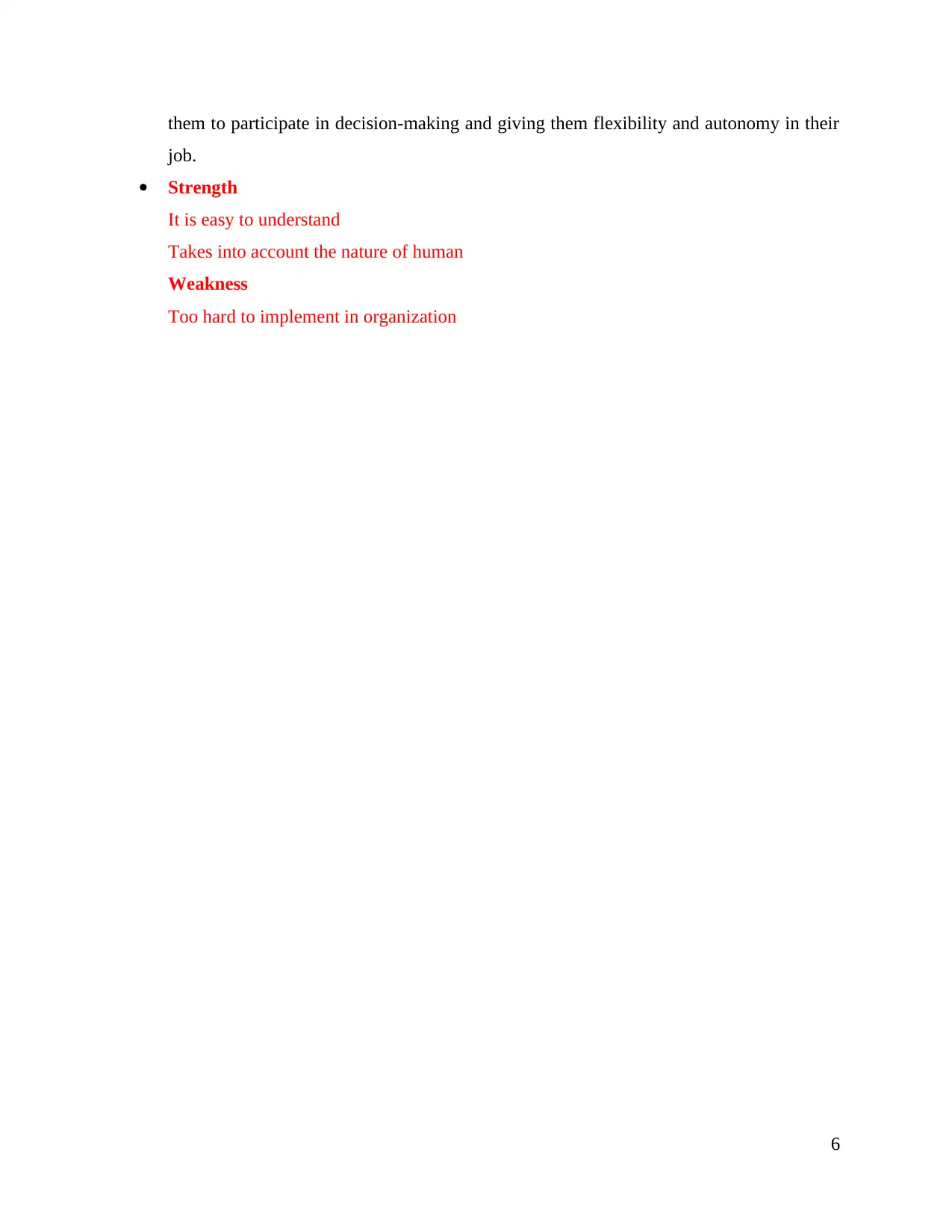
them to participate in decision-making and giving them flexibility and autonomy in their
job.
Strength
It is easy to understand
Takes into account the nature of human
Weakness
Too hard to implement in organization
6
job.
Strength
It is easy to understand
Takes into account the nature of human
Weakness
Too hard to implement in organization
6
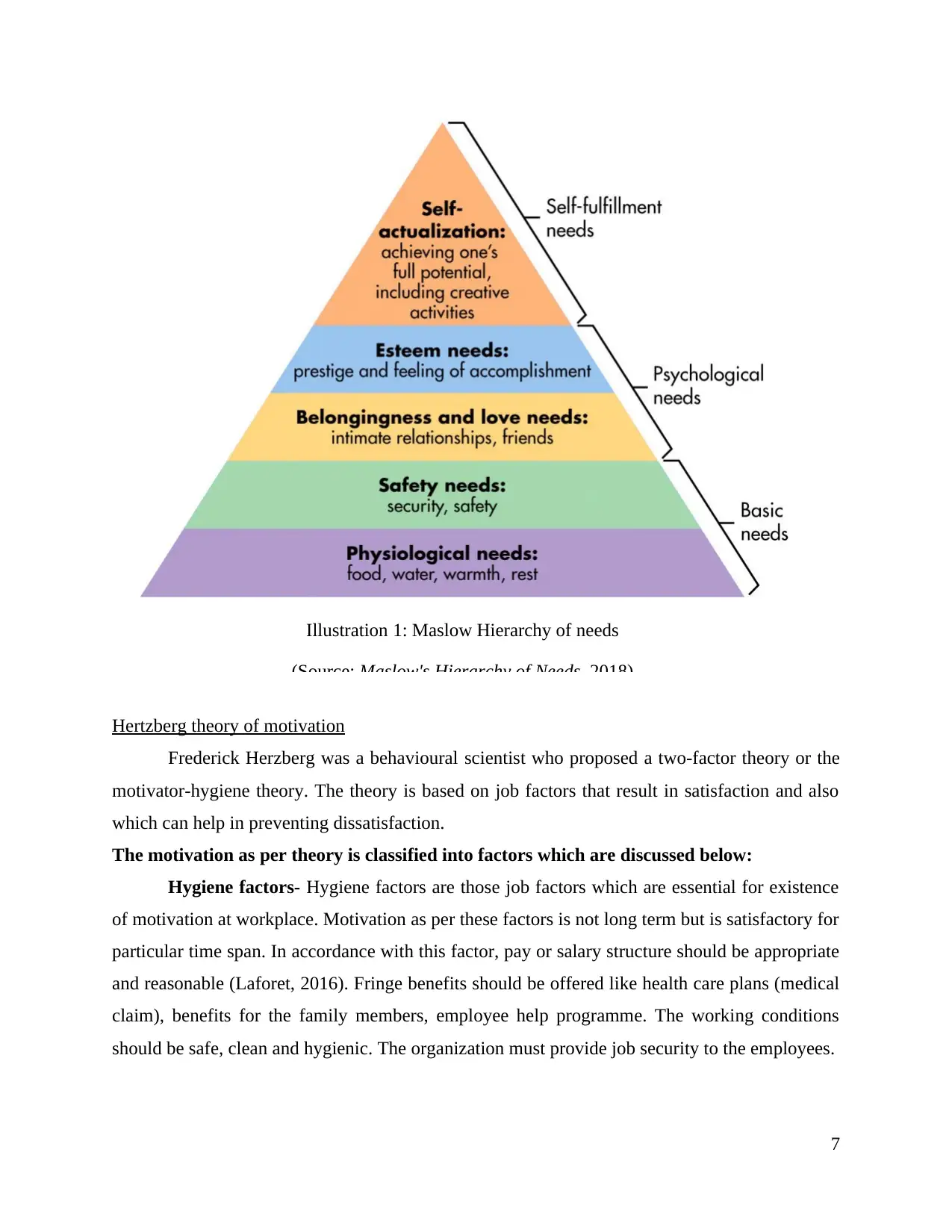
Hertzberg theory of motivation
Frederick Herzberg was a behavioural scientist who proposed a two-factor theory or the
motivator-hygiene theory. The theory is based on job factors that result in satisfaction and also
which can help in preventing dissatisfaction.
The motivation as per theory is classified into factors which are discussed below:
Hygiene factors- Hygiene factors are those job factors which are essential for existence
of motivation at workplace. Motivation as per these factors is not long term but is satisfactory for
particular time span. In accordance with this factor, pay or salary structure should be appropriate
and reasonable (Laforet, 2016). Fringe benefits should be offered like health care plans (medical
claim), benefits for the family members, employee help programme. The working conditions
should be safe, clean and hygienic. The organization must provide job security to the employees.
7
Illustration 1: Maslow Hierarchy of needs
(Source: Maslow's Hierarchy of Needs, 2018)
Frederick Herzberg was a behavioural scientist who proposed a two-factor theory or the
motivator-hygiene theory. The theory is based on job factors that result in satisfaction and also
which can help in preventing dissatisfaction.
The motivation as per theory is classified into factors which are discussed below:
Hygiene factors- Hygiene factors are those job factors which are essential for existence
of motivation at workplace. Motivation as per these factors is not long term but is satisfactory for
particular time span. In accordance with this factor, pay or salary structure should be appropriate
and reasonable (Laforet, 2016). Fringe benefits should be offered like health care plans (medical
claim), benefits for the family members, employee help programme. The working conditions
should be safe, clean and hygienic. The organization must provide job security to the employees.
7
Illustration 1: Maslow Hierarchy of needs
(Source: Maslow's Hierarchy of Needs, 2018)
⊘ This is a preview!⊘
Do you want full access?
Subscribe today to unlock all pages.

Trusted by 1+ million students worldwide
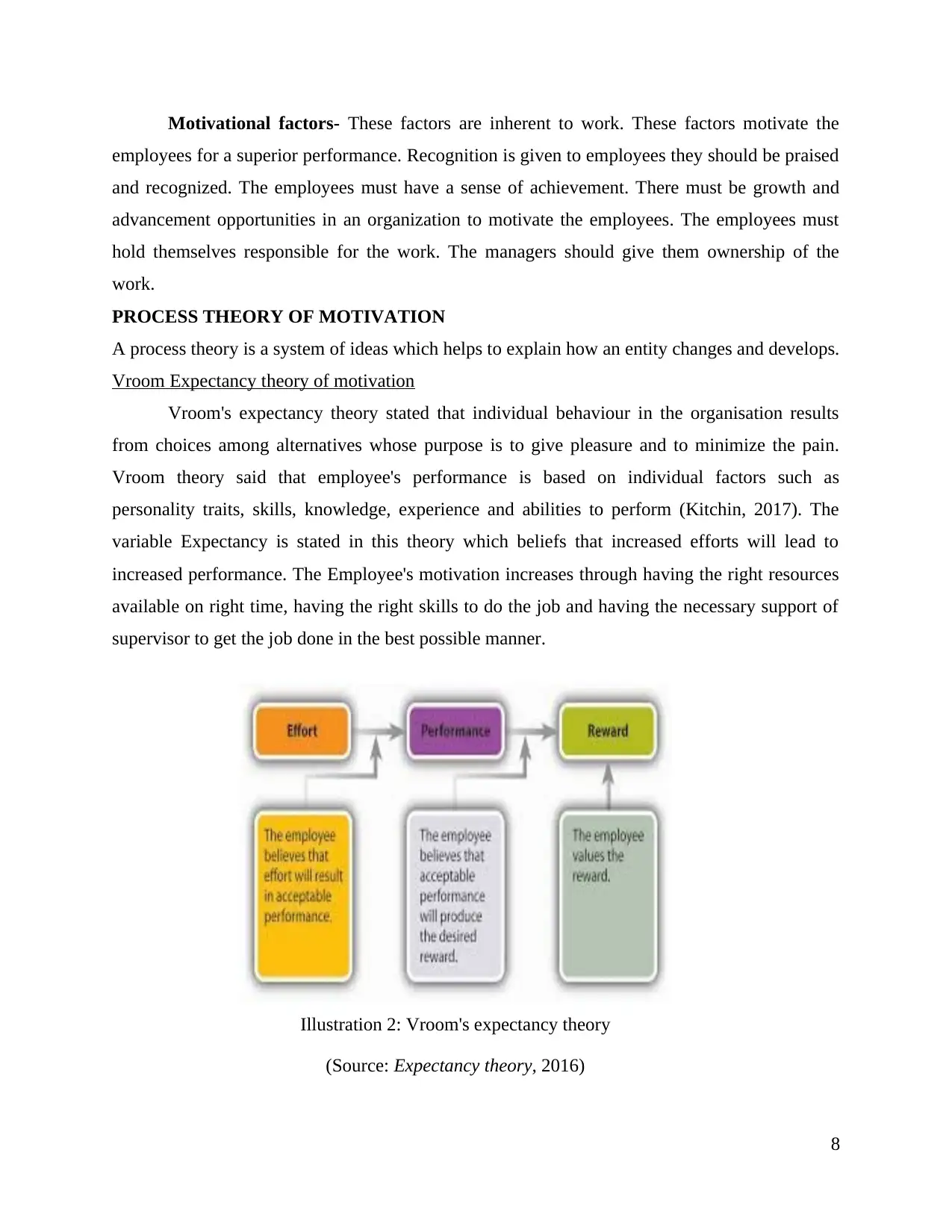
Motivational factors- These factors are inherent to work. These factors motivate the
employees for a superior performance. Recognition is given to employees they should be praised
and recognized. The employees must have a sense of achievement. There must be growth and
advancement opportunities in an organization to motivate the employees. The employees must
hold themselves responsible for the work. The managers should give them ownership of the
work.
PROCESS THEORY OF MOTIVATION
A process theory is a system of ideas which helps to explain how an entity changes and develops.
Vroom Expectancy theory of motivation
Vroom's expectancy theory stated that individual behaviour in the organisation results
from choices among alternatives whose purpose is to give pleasure and to minimize the pain.
Vroom theory said that employee's performance is based on individual factors such as
personality traits, skills, knowledge, experience and abilities to perform (Kitchin, 2017). The
variable Expectancy is stated in this theory which beliefs that increased efforts will lead to
increased performance. The Employee's motivation increases through having the right resources
available on right time, having the right skills to do the job and having the necessary support of
supervisor to get the job done in the best possible manner.
8
Illustration 2: Vroom's expectancy theory
(Source: Expectancy theory, 2016)
employees for a superior performance. Recognition is given to employees they should be praised
and recognized. The employees must have a sense of achievement. There must be growth and
advancement opportunities in an organization to motivate the employees. The employees must
hold themselves responsible for the work. The managers should give them ownership of the
work.
PROCESS THEORY OF MOTIVATION
A process theory is a system of ideas which helps to explain how an entity changes and develops.
Vroom Expectancy theory of motivation
Vroom's expectancy theory stated that individual behaviour in the organisation results
from choices among alternatives whose purpose is to give pleasure and to minimize the pain.
Vroom theory said that employee's performance is based on individual factors such as
personality traits, skills, knowledge, experience and abilities to perform (Kitchin, 2017). The
variable Expectancy is stated in this theory which beliefs that increased efforts will lead to
increased performance. The Employee's motivation increases through having the right resources
available on right time, having the right skills to do the job and having the necessary support of
supervisor to get the job done in the best possible manner.
8
Illustration 2: Vroom's expectancy theory
(Source: Expectancy theory, 2016)
Paraphrase This Document
Need a fresh take? Get an instant paraphrase of this document with our AI Paraphraser
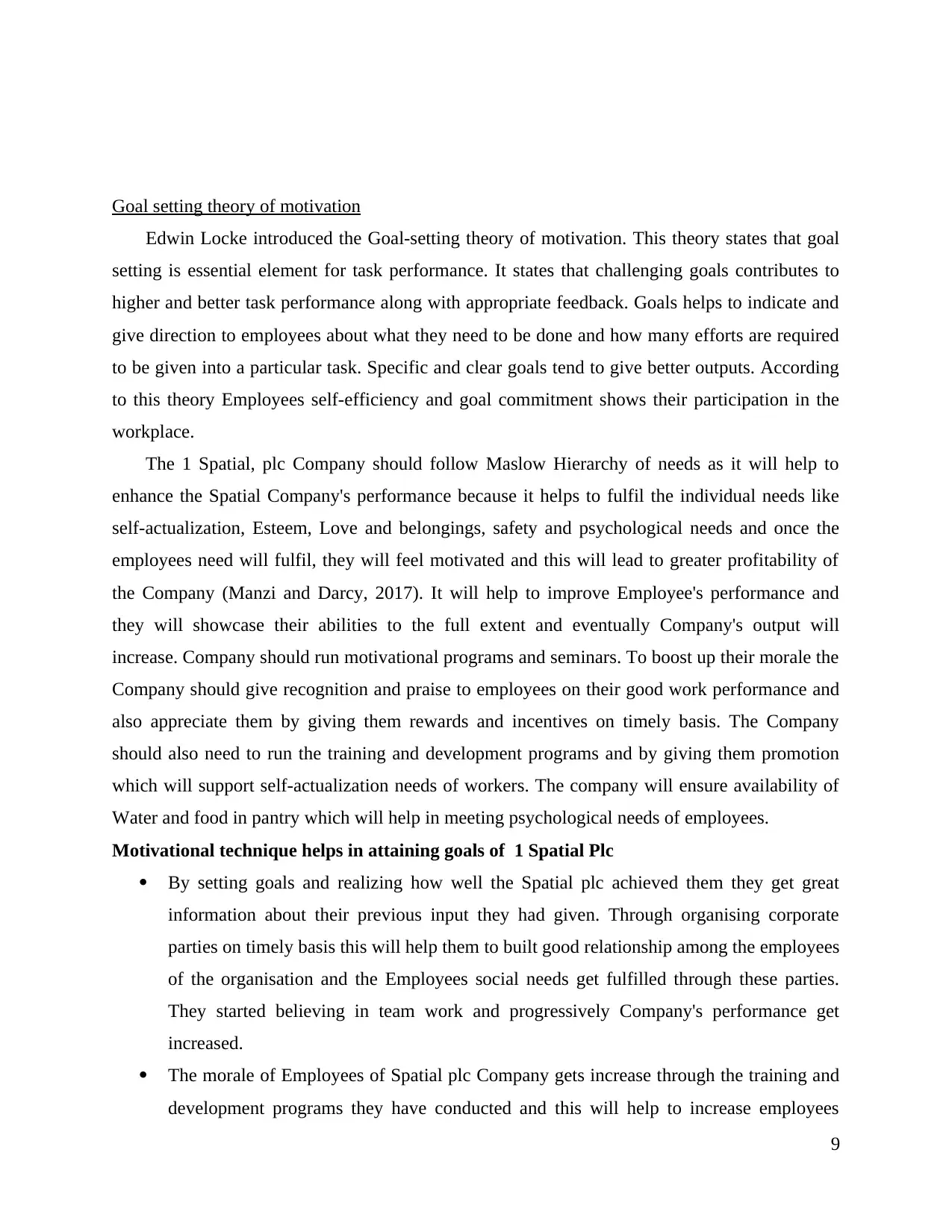
Goal setting theory of motivation
Edwin Locke introduced the Goal-setting theory of motivation. This theory states that goal
setting is essential element for task performance. It states that challenging goals contributes to
higher and better task performance along with appropriate feedback. Goals helps to indicate and
give direction to employees about what they need to be done and how many efforts are required
to be given into a particular task. Specific and clear goals tend to give better outputs. According
to this theory Employees self-efficiency and goal commitment shows their participation in the
workplace.
The 1 Spatial, plc Company should follow Maslow Hierarchy of needs as it will help to
enhance the Spatial Company's performance because it helps to fulfil the individual needs like
self-actualization, Esteem, Love and belongings, safety and psychological needs and once the
employees need will fulfil, they will feel motivated and this will lead to greater profitability of
the Company (Manzi and Darcy, 2017). It will help to improve Employee's performance and
they will showcase their abilities to the full extent and eventually Company's output will
increase. Company should run motivational programs and seminars. To boost up their morale the
Company should give recognition and praise to employees on their good work performance and
also appreciate them by giving them rewards and incentives on timely basis. The Company
should also need to run the training and development programs and by giving them promotion
which will support self-actualization needs of workers. The company will ensure availability of
Water and food in pantry which will help in meeting psychological needs of employees.
Motivational technique helps in attaining goals of 1 Spatial Plc
By setting goals and realizing how well the Spatial plc achieved them they get great
information about their previous input they had given. Through organising corporate
parties on timely basis this will help them to built good relationship among the employees
of the organisation and the Employees social needs get fulfilled through these parties.
They started believing in team work and progressively Company's performance get
increased.
The morale of Employees of Spatial plc Company gets increase through the training and
development programs they have conducted and this will help to increase employees
9
Edwin Locke introduced the Goal-setting theory of motivation. This theory states that goal
setting is essential element for task performance. It states that challenging goals contributes to
higher and better task performance along with appropriate feedback. Goals helps to indicate and
give direction to employees about what they need to be done and how many efforts are required
to be given into a particular task. Specific and clear goals tend to give better outputs. According
to this theory Employees self-efficiency and goal commitment shows their participation in the
workplace.
The 1 Spatial, plc Company should follow Maslow Hierarchy of needs as it will help to
enhance the Spatial Company's performance because it helps to fulfil the individual needs like
self-actualization, Esteem, Love and belongings, safety and psychological needs and once the
employees need will fulfil, they will feel motivated and this will lead to greater profitability of
the Company (Manzi and Darcy, 2017). It will help to improve Employee's performance and
they will showcase their abilities to the full extent and eventually Company's output will
increase. Company should run motivational programs and seminars. To boost up their morale the
Company should give recognition and praise to employees on their good work performance and
also appreciate them by giving them rewards and incentives on timely basis. The Company
should also need to run the training and development programs and by giving them promotion
which will support self-actualization needs of workers. The company will ensure availability of
Water and food in pantry which will help in meeting psychological needs of employees.
Motivational technique helps in attaining goals of 1 Spatial Plc
By setting goals and realizing how well the Spatial plc achieved them they get great
information about their previous input they had given. Through organising corporate
parties on timely basis this will help them to built good relationship among the employees
of the organisation and the Employees social needs get fulfilled through these parties.
They started believing in team work and progressively Company's performance get
increased.
The morale of Employees of Spatial plc Company gets increase through the training and
development programs they have conducted and this will help to increase employees
9
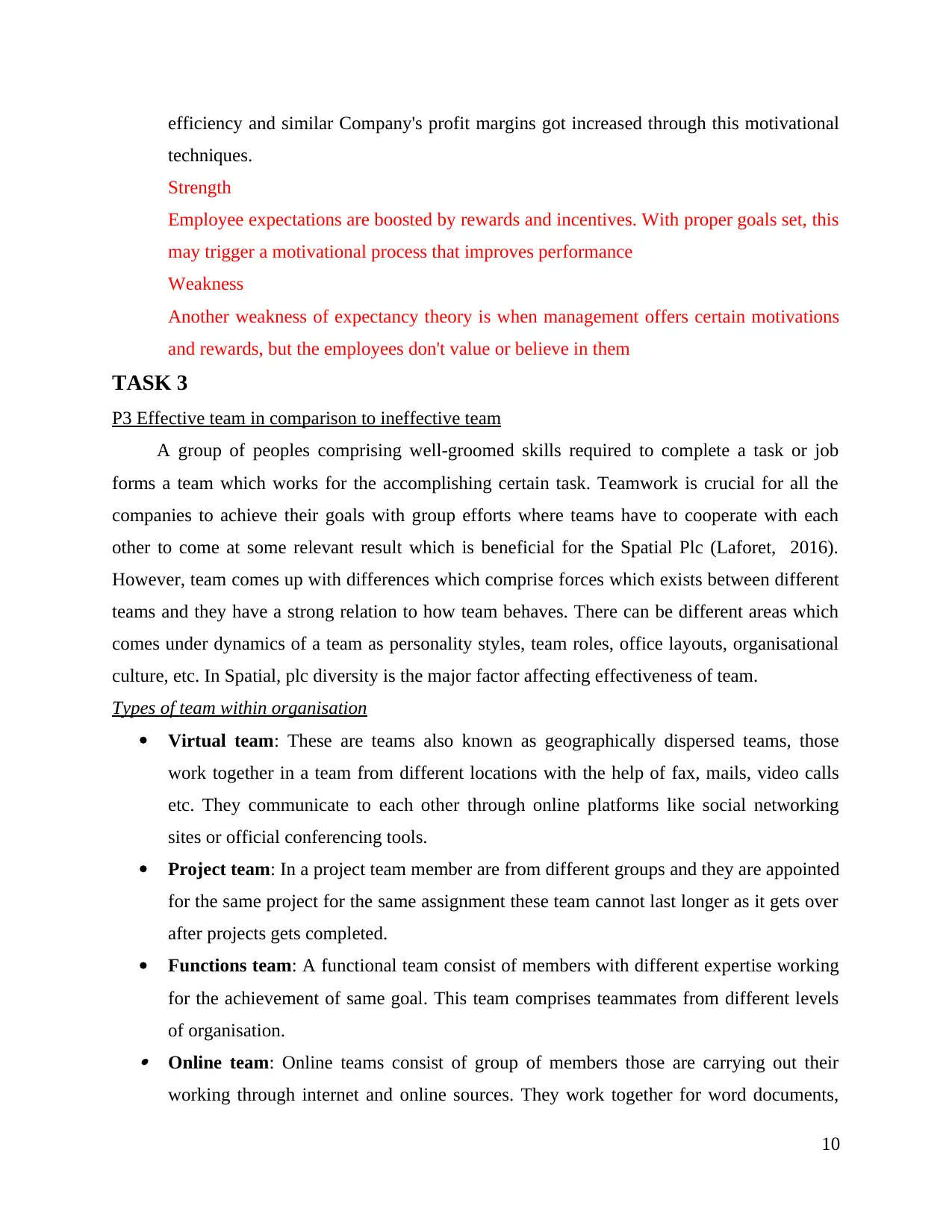
efficiency and similar Company's profit margins got increased through this motivational
techniques.
Strength
Employee expectations are boosted by rewards and incentives. With proper goals set, this
may trigger a motivational process that improves performance
Weakness
Another weakness of expectancy theory is when management offers certain motivations
and rewards, but the employees don't value or believe in them
TASK 3
P3 Effective team in comparison to ineffective team
A group of peoples comprising well-groomed skills required to complete a task or job
forms a team which works for the accomplishing certain task. Teamwork is crucial for all the
companies to achieve their goals with group efforts where teams have to cooperate with each
other to come at some relevant result which is beneficial for the Spatial Plc (Laforet, 2016).
However, team comes up with differences which comprise forces which exists between different
teams and they have a strong relation to how team behaves. There can be different areas which
comes under dynamics of a team as personality styles, team roles, office layouts, organisational
culture, etc. In Spatial, plc diversity is the major factor affecting effectiveness of team.
Types of team within organisation
Virtual team: These are teams also known as geographically dispersed teams, those
work together in a team from different locations with the help of fax, mails, video calls
etc. They communicate to each other through online platforms like social networking
sites or official conferencing tools.
Project team: In a project team member are from different groups and they are appointed
for the same project for the same assignment these team cannot last longer as it gets over
after projects gets completed.
Functions team: A functional team consist of members with different expertise working
for the achievement of same goal. This team comprises teammates from different levels
of organisation. Online team: Online teams consist of group of members those are carrying out their
working through internet and online sources. They work together for word documents,
10
techniques.
Strength
Employee expectations are boosted by rewards and incentives. With proper goals set, this
may trigger a motivational process that improves performance
Weakness
Another weakness of expectancy theory is when management offers certain motivations
and rewards, but the employees don't value or believe in them
TASK 3
P3 Effective team in comparison to ineffective team
A group of peoples comprising well-groomed skills required to complete a task or job
forms a team which works for the accomplishing certain task. Teamwork is crucial for all the
companies to achieve their goals with group efforts where teams have to cooperate with each
other to come at some relevant result which is beneficial for the Spatial Plc (Laforet, 2016).
However, team comes up with differences which comprise forces which exists between different
teams and they have a strong relation to how team behaves. There can be different areas which
comes under dynamics of a team as personality styles, team roles, office layouts, organisational
culture, etc. In Spatial, plc diversity is the major factor affecting effectiveness of team.
Types of team within organisation
Virtual team: These are teams also known as geographically dispersed teams, those
work together in a team from different locations with the help of fax, mails, video calls
etc. They communicate to each other through online platforms like social networking
sites or official conferencing tools.
Project team: In a project team member are from different groups and they are appointed
for the same project for the same assignment these team cannot last longer as it gets over
after projects gets completed.
Functions team: A functional team consist of members with different expertise working
for the achievement of same goal. This team comprises teammates from different levels
of organisation. Online team: Online teams consist of group of members those are carrying out their
working through internet and online sources. They work together for word documents,
10
⊘ This is a preview!⊘
Do you want full access?
Subscribe today to unlock all pages.

Trusted by 1+ million students worldwide
1 out of 18
Related Documents
Your All-in-One AI-Powered Toolkit for Academic Success.
+13062052269
info@desklib.com
Available 24*7 on WhatsApp / Email
![[object Object]](/_next/static/media/star-bottom.7253800d.svg)
Unlock your academic potential
Copyright © 2020–2025 A2Z Services. All Rights Reserved. Developed and managed by ZUCOL.




